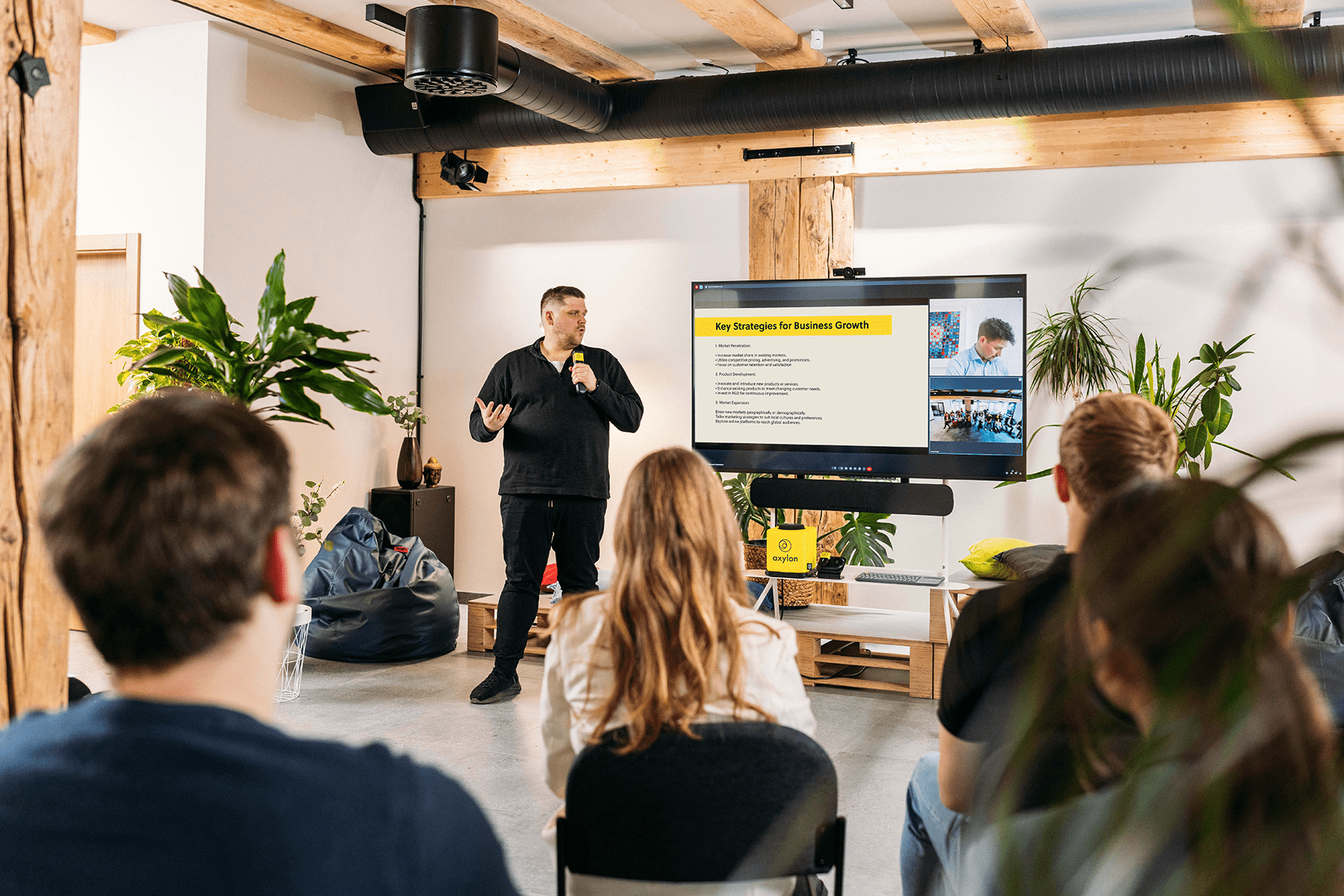How to run a hybrid all-hands meeting
Bridging the gap between in-person and remote collegues in distributed teams

Edited on: April 23, 2025
All-hands meetings have always been a challenge – finding the time and space for an entire company to come together is difficult. Well, except for fully remote teams, for whom the logistical challenges start and end at creating and clicking a Zoom meeting link.
And today, as many of us work in hybrid setups, the challenge has evolved. Now, these meetings need to engage two audiences at once: those in the room and those joining remotely.
Technology is what bridges that gap.
In this article, we’ll break down what hybrid all-hands meetings are, the technology for hybrid meetings you’ll need to run them effectively, and share some best practices to make your next event a success.
What is a hybrid all-hands meeting?
A hybrid all-hands meeting is a company-wide meeting where some team members attend in person, while others join remotely through platforms like Zoom or Microsoft Teams.
The goal remains the same: to share company updates, celebrate wins, and foster a unified culture. Usually, leadership presents key developments, teams showcase progress, and a Q&A wraps it all up.
What makes these meetings hybrid is the technical setup.
Unlike remote meetings, which rely on individual laptops, or in-person meetings that just need a microphone and speakers, hybrid all-hands require an integrated system of microphones, speakers, cameras, and displays to connect both remote and in-room participants seamlessly.
Technology for hybrid all-hands meetings
There are two essential categories to cover: audio and video. Everyone should be able to clearly hear and see the presenters, regardless of their location.
The specific configuration will vary depending on the size of your space, your current tech setup, and how many people are attending in person. But some core elements are non-negotiable.
Audio for hybrid all-hands meetings
A great hybrid meeting starts with great sound. That means setting up three core components:
Microphones for presenters
An audience microphone
A speaker system
This is non-negotiable.
Presenter microphone
Ensures your remote attendees hear everything clearly. Relying on a laptop mic might technically work, but it limits speaker movement and results in poor sound quality.
A clip-on or handheld wireless mic allows speakers to move naturally, address the room confidently, and still be heard online. When choosing a microphone for hybrid meetings, go for one that’s easy to use, reliable, and compatible with your video conferencing software.
Audience microphones
If you’re planning a Q&A or want to encourage any in-room engagement, an audience microphone is essential. Without it, your remote attendees will miss out on half the conversation.
That’s where a wireless conference room microphone system like Catchbox Plus makes all the difference.
Catchbox Plus offers three types of wireless mics:
- A Clip mic for hands-free presenting
- A Stick mic for handheld use
- And the original Cube mic, encased in soft, throwable foam for safe, fast audience participation.
If you’re looking for the best microphone for hybrid meetings, Catchbox Plus is a plug-and-play solution trusted in both corporate and education environments.
Speaker systems
As to the third and final element of your audio setup—the speaker system—most systems will do. The primary function of this system is to ensure that the in-person participants can hear what the remote ones are saying, with their voices broadcast across the event hall. The speaker system can also be used to amplify the presenter's voice, but that's not as important unless you're expecting a huge in-person audience.
Video equipment for all-hands meetings
With the audio sorted, let's move on to the video side of it.
For video, you'll need two things:
- A camera to stream the in-person experience
- A screen, large display, or projector to show virtual presenters and content
The camera is used to capture the stage in good enough quality for remote viewing. Whereas the projector will ensure that in-person attendees can see the presentations.
These are the two basic elements that will be enough for a good hybrid all-hands meeting setup.
But when it comes to video, there are several further upgrades you can make, depending on your budget and needs. For example, you can add another screen or display in the event hall for the sole purpose of showing the remote attendees.
You can also add an audience camera so that the virtual attendees can see their on-site colleagues.
These extra elements can help the entire team feel more united, which is one of the goals of all-hands meetings. However, they increase the complexity of the setup, they're costly, and they make technical issues more likely.
If all-hands meetings are a regular and important occurrence in your company, then it certainly makes sense to invest in such extras. But for most of us, a simple camera + projector setup will do the job.
3 things to keep in mind for a successful hybrid all-hands meeting
Even with the best gear, a great hybrid all-hands comes down to execution. Here’s what makes the difference:
1. Assign a host
A designated moderator keeps things moving, introduces speakers, and manages transitions. This prevents awkward silences and helps the meeting stay on track.
2. Have a dedicated tech support person
Technical hiccups are inevitable. But if you’ve got 80 people tuned in and lose 5 minutes to troubleshooting, that’s nearly 7 hours of lost productivity. A dedicated support person ensures quick problem-solving and minimal frustration.
3. Break it up with engagement
Long meetings test attention spans—especially for remote attendees who can easily zone out. Break things up with interactive moments:
- Host a live Q&A using a throwable group microphone
- Run live polls or quizzes with tools like Slido
- Schedule a 5-minute stretch break
The more people participate, the more they'll remember.
Final remarks
Hybrid all-hands meetings are no longer just a workaround—they’re the new standard for distributed teams. With the right setup and mindset, they can be just as engaging as traditional meetings, if not more so.
Get your hybrid meeting audio solutions in place with quality microphones for hybrid Zoom meetings or Teams calls, and the rest will follow.
Related reads
Tackling auditory distractions in meetings
From noisy HVAC units to frustrating laptop mics, this article exposes what’s really killing your meeting flow—and how to fix it without breaking your budget.
Crystal clear audio: why it matters for live captions
Are your meetings truly accessible? Learn why clear audio isn’t just about quality—it’s a compliance essential. From live captioning to inclusive recordings.
Catchbox for hybrid collaboration
Case studies

Airtame
#corporate
“If your company does something like all-hands or town hall meetings, I would recommend going for the Catchbox Plus with the Clip Mic. We keep the presenter mic at the front of the room and pass the Catchbox between the audience.”

Slido
#corporate
Quick, effective voice transition is a simple thing but it makes such a difference. We always try to keep online participants in mind and with Catchbox, there’s no delays or wait times and the audio quality is always excellent. As a result, our remote guys always feel fully involved in the meetings.